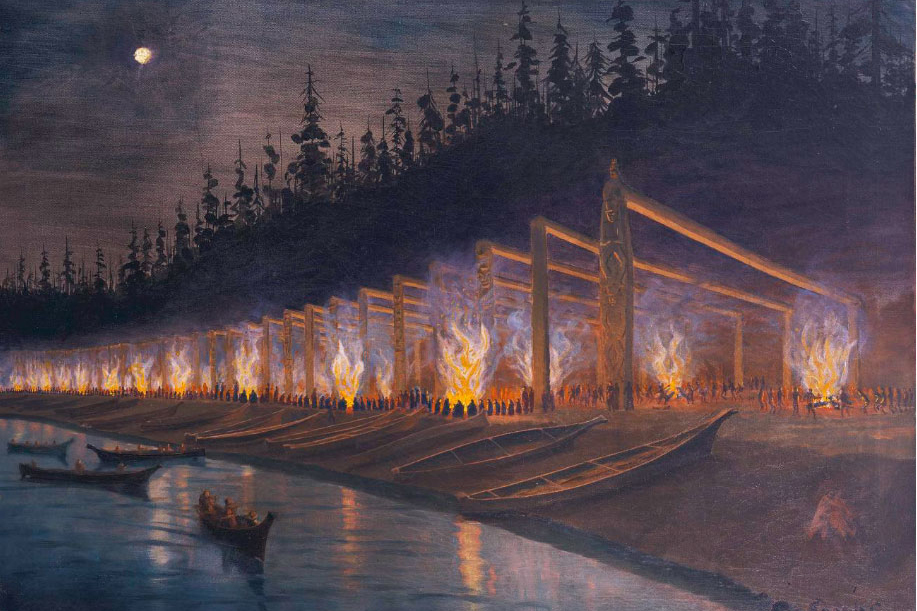If Hiram Chittenden had been present at the big solidarity-for-Standing Rock rally held outside the Army Corps of Engineers’ Hiram Chittenden Locks in Ballard two weeks ago, he probably wouldn’t have been surprised that Native Americans were once again going head-to-head with the Corps.
After all, be it an Army Corps dam that’s going to flood Native land or a pipeline that’s going to poison it, the Corps has never been popular with the continent’s original inhabitants. To Chittenden, who spent his career with the agency and designed the Locks, the most surprising thing about the protest would have been that 99 years after his death, Natives still survived. He was so positive they’d all be dead by now that he even wrote a poem from the perspective of the last Native on Earth, “The Redman’s Farewell”:
List, list, stormy waters, this once and no more,’Tis the last of the Redmen who calls from your shore… . Farewell now to mountain and prairie and shore,Their empire the Redman possesses no more.
The full poem goes on for pages, but its gist is that Natives are naturally allergic to the future, and would die out no matter what. With all the Earth’s “barbarian” races subdued, and war between the “civilized” nations becoming unthinkable, it seemed as if the future wouldn’t even have need for a military, Chittenden thought, which is why in his 1911 book War or Peace (published five years before the first World War) he proposed that all the world’s armies be dismantled and replaced with a one-world government to solve future disputes. He was still firm that non-whites not be allowed to enter the United States, even under the one-world government, for fear of racial mixing. He also acknowledged that without war we would need a new form of population control, and proposed that society should gather those with “natural infirmities and put them out of the way by any of the painless processes known to science, thus accomplishing at insignificant cost the double purpose of restricting population and improving its quality.”
Chittenden’s peace doesn’t sound like a great improvement over war, and similarly many of his employers’ projects have caused a huge amount of irreversible environmental destruction in the name of improvement. Due to its nebulous legal standing as a half-military, half-civilian organization that receives authorization directly from Congress (often to the opposition of local government), the Army Corps of Engineers has enjoyed enormous latitude in its projects, freed from many of the legal constraints that would plague lesser federal bureaucracies.
The 1986 classic Cadillac Desert by Marc Reisner is still the most complete and readable account of the Corps’ history of seizing Native land, draining wetlands, and using crypto-government authority to override state laws. This standard operating procedure didn’t end in Chittenden’s time. Right now, just north of the Standing Rock Reservation in North Dakota, the Corps is being used by oil companies to try to run a pipeline through Native graves and beneath the lake and river which provide the Sioux’s drinking water. Of course, without the Army Corps of Engineers’ involvement, this would all be illegal. This past weekend, the Corps announced it would clear protesters from the area in the name of safety, a striking metaphor for what the U.S. government has been doing to Natives since its creation: clearing them off the land in the name of “progress.”
Related coverage: Home From Standing Rock, Seattle Protesters Bring Pipeline Fight to the Corps
Chittenden enlisted in the Corps in 1884, just as the agency’s civilian division was transitioning away from its previous duty of clearing sunken ships out of harbors and into what it is now, an agency that physically reshapes the continent. Chittenden was one of the first army engineers to propose that the Corps get involved in building reservoirs for agricultural irrigation.
In general, Chittenden never revealed more about his personal outlook on life than when he thought he was simply stating an objective truth. In an essay titled Manifest Destiny he outlines every possible path for American expansion, and argues that no matter what, things would have wound up the way they did for both whites and Native Americans. As there was nothing the individual could do about it, he argued, the only option was to embrace it: “Nations, like individuals, grow with years and the truly rational view is to foster such growth in every legitimate way,” he wrote in his three-volume The American Fur Trade of the Far West. He felt free will was largely an illusion. Because he didn’t think much of freedom, it is fitting that he worked for an organization whose insignia is a castle—the ultimate symbol of undemocratic, received authority.
Chittenden writes that he often felt trapped in the Corps, as he was sent from assignment to assignment without much control over his own life. He was assigned as a district engineer to Seattle in 1906 shortly after a partially completed dam on the Osage River in Missouri collapsed due to an error in his engineering.
Topographically, Chittenden declared, Seattle had more “scenic beauty than any other city of ancient or modern times.” Of the native Salish population, he wrote, “They were less strong physically than the plains Indians, of inferior build, and in no sense comparable to them as specimens of physical manhood.” The most striking thing about that passage isn’t that it is racist, but that he is already referring to them in the past tense.
Though the Salish still had a large presence in turn-of-the-century Seattle, Chittenden basically went about his Army Corps of Engineers duties as if they no longer existed. His charge was to design a system by which cargo ships could travel from Puget Sound to Lake Washington. The solution: a new canal through Montlake, Fremont, and Ballard.
The Locks were necessary to account for the elevation difference between the two bodies of water. Since the project would create a new, deep outlet for Lake Washington, it would lower the lake level significantly. While working on the Locks and canal, Chittenden pondered what effects lowering Lake Washington’s water level would have on the environment. He argued that the main effect would just be aesthetic, and even that would be minor. White people with lakefront property had nothing to worry about: “The change in shoreline along residence districts will be only slight and will become inappreciable within one or two years.” That turned out to be totally untrue; after the opening of the ship canal, Lake Washington’s water level was lowered by nine feet, shrinking more than 10 miles of shoreline and permanently destroying over 93 percent of the wetlands around the lake. Chittenden goes on to say that the lowering of Lake Washington is “a case where utilitarian ends can be accomplished without any sacrifice of sentimental interest.”
It was a bold move to talk about what constituted “sentimental interest” in a region he had lived in for only a couple of years. The lowering of Lake Washington permanently cut off the flow to its natural outlet, the Black River, which ran through present-day Renton en route to the Duwamish River and had far more than “sentimental” interest for the people who’d been here since the time of the glaciers. Many Duwamish still lived along the Black River in the early 20th century; in fact, those who lived on the Black River were often considered to be the “true” Duwamish, and in many ways life continued on it the way it had before the settlers showed up.
According to David Buerge, author of an upcoming, long-awaited biography of Chief Seattle, the Duwamish believed the Black River was home to many supernatural beings, including “Weeping Mother,” a river goddess who caused the springtime floods. A hole at the bottom of the river was the lair of a powerful spirit disguised as a long-haired man, who granted wealth to those brave enough to dive into the dark, sediment-rich waters in search of his powers. On the river’s bank was a hill crawling with piles of slithering garter snakes, the “hill of the earth beings,” which had existed even before the Changer created the modern world, and not even his magic had been able to touch it. Inside the hill lived a race of primordial dwarves, older than humanity, who jealously loved the land and cared for it like doctors.
Less esoterically, the river was home to a vibrant ecosystem, including seals, the occasional lost whale, and, most important, thousands of salmon that the Duwamish had relied on since their creation. Weeping Mother and salmon alike vanished forever on the day in 1916 when the Army Corp of Engineers lowered the lake, cutting off the flow to the Black River. In the 1950s, one of the very last Duwamish who used to live on the river still remembered the day it died. “That was quite a day for the white people at least. The waters just went down, down, until our landing and canoes stood dry and there was no Black River at all. There were pools of course, and the struggling fish trapped in them. People came from miles around, laughing, and hollering, and stuffing the fish into gunny sacks.”
For all the environmental destruction and displacement of Native people they caused, no other place in Seattle seems to so live up to the Northwest idea of man and nature living together as the Locks do. The gray cement buildings mix perfectly with the green slopes of grass, great blue heron, seals, and salmon. That’s by design. As Chittenden himself said, “True architecture rears its edifices in harmony with the environment in which they stand.” In terms of environmental stewardship, the inclusion of a fish ladder in his designs for the Locks puts him several tiers above Floyd Dominy, Commissioner of the Bureau of Reclamation a generation after Chittenden. After the Reclamation-built Grand Coulee Dam cut off salmon from huge swaths of spawning grounds, Dominy was asked about the dam’s impact on the fish. His response: “There’s substitutes for eating salmon. You can eat cake.” Then he smirked at his own joke.
Chittenden didn’t personally benefit that much from his work for the Corps. In 1907, President Teddy Roosevelt decided that anybody manly enough to be an officer in the U.S. army had to be able to ride a horse for 50 miles, unless they were in the infantry. This new requirement was added to the annual physical examination, and those who didn’t pass would be forced to retire. The task was daunting for Chittenden, who had suffered from bouts of typhoid and other ailments contracted from a life outdoors. But there was no way Chittenden could have been able to support his wife and three children on his then-current pension, so he took the ride on his 49th birthday, October 25, 1907.
He passed the test, but after getting off the horse his health quickly deteriorated, with the occasional paralysis in his legs becoming more frequent. He began to suffer from depression; and two months after the horse incident he checked into Seattle’s Pacific Hospital for electroshock therapy. By 1911 his legs were almost completely paralyzed, and he had to retire from the Army to spend the rest of his life in a wheelchair. Despite a lifetime military career in which he never engaged in combat against anything besides the Earth, he wound up just as mangled as those of his generation who fought Native American tribes more directly.
Physical construction of the Locks did not begin until immediately after Chittenden’s retirement in 1911, but the construction so closely followed his plans that in 1956 the generically named Government Locks became the Hiram M. Chittenden Locks.
It would be interesting to know if, while he sat in a wheelchair on the porch of his Ballard home a few months before his death in 1917, watching the ships go by for the Lake Washington Canal’s opening ceremony, Chittenden thought about his former neighbor, who had experienced the dark side of peace first-hand. The last headman (a term closer to “community organizer” than Chief) of the Shilshole, Salmon Bay Charlie, was a fixture in turn-of-the-century Ballard.
Even before white settlers arrived in Ballard the native Shilshole had already been hit hard by smallpox, and other tribes took advantage of their diminished population to capture them as slaves. By the time Chittenden arrived in Ballard, Salmon Bay Charlie and his wife Madeleine would have been one of the few reminders that like everywhere else in America, Ballard used to be Native. According to a 1990 piece in the history journal The Columbia, local kids remembered the way Charlie used to show off all his scars from fighting the northern slave raiders that tried to kidnap him and his people. It wasn’t until Charlie’s old age, toward the end of the Locks’ construction in 1915, and a few months after the death of his wife, that Indian Agents were able to come in and calmly carry him off without a struggle—in a way that war-canoe-loads of armed Haida couldn’t. He lived out the rest of his life at Chief Seattle’s Port Madison reservation.
As to why exactly Salmon Bay Charlie was carried off by the government, there is no clear explanation. Many local historians have claimed that he was moved because his land was in an area about to be flooded by the Locks; but according to Buerge, Charlie’s house was too far west to be harmed (the precise location has been lost to history). Buerge’s own suspicion is that with Ballard property becoming more valuable because of the Locks, Charlie’s white neighbors just wanted his land, and now they could take it because he was old and there were barely any of his people left.
Whether or not he was aware of Charlie, the old headman’s fate wouldn’t have surprised Chittenden for a couple of reasons. He believed that Natives were so destined to lose their land that the government shouldn’t even have bothered to make treaties; also, Chittenden was fully aware that peace can hold as much danger as war. In an essay on the importance of heroism in peacetime, he said, “The ancient feudal castle, so often used as a base of operations in despoiling the surrounding country and exacting tribute from the weak, no longer exists as a physical fact; but there do exist more powerful and relentless tyrannies,” which he goes on to describe as people in unjustly-won positions of supremacy using their powers corruptly. It’s unlikely his mention of a “feudal castle” referred to the Army Corps of Engineers’ castle insignia, but that is probably the first thing that would come to mind to the protesters at Standing Rock.
Native Americans know the dangers of peace probably better than any demographic in America. Right now in North Dakota, if they weren’t getting maced and mauled by cops and attack dogs, the Corps would not hesitate to build that pipeline through their water supply. If it leaked, there would be less physical violence than with the demonstration, but more people would be harmed. One of the main lessons to take from Chittenden’s good and bad examples is that the ultimate goal shouldn’t be peace, but good peace. The first step should be trying to find a word for it. It’s not in anything written by Chittenden.










